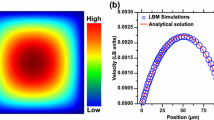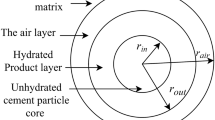Abstract
As the temperature of a saturated porous medium drops, the water in the pores starts to freeze. Since the temperature at which the phase change takes place is dependent on the pore size, the permeability of the medium changes continuously. Simultaneously, due to the expansion of water on freezing, it is forced to migrate through the pore body thus inducing stresses in material matrix. The stresses developed and the consequent frost damage are therefore dependent on the change in the permeability characteristics of the medium on freezing. This paper deals with the numerical prediction of permeability characteristics of porous cemented media saturated with water undergoing progressive freezing.
A bond percolation model is used to generate the pore structure according to an assumed poresize distribution. Permeability of the medium at various temperatures is computed by solving the network problem. The computed results are compared with other analytical and experimental results. The proposed model predicts a threshold temperature below which permeability drops to zero. This phenomenon is crucial in developing a deeper understanding of the mechanism of frost damage to cemented porous materials such as bricks, stone, concrete, etc.
Similar content being viewed by others
References
Androutsopoulos, G. P. and Mann, R.: 1979, Evaluation of mercury porosimeter experiments using a network pore structure model, Chemical Engineering Science 34, 1203–1212.
Berkowitz, B. and Balberg, I.: 1992, Percolation approach to the problem of hydraulic conductivity in porous media, Transport in Porous Media 9, 275–286.
Blachere, J. R. and Young, J. E.: 1972, The freezing point of water in porous glass, J. Am. Ceramic Soc. 55, 306–308.
Brebbia, C. A. and Ferrante, A. J.: 1983, Computational Hydraulics, Butterworths, London.
Burt, T. P. and Williams, P. J.: 1976, Hydraulic conductivity in frozen soils, Earth Surface Processes 1, 1.
Carman, P. C.: 1937, Fluid flow through granular beds, Trans. Inst. Chem. Eng. 15, 150–166.
Chatzis, I. and Dullien, F. A. L.: 1985, The modelling of mercury porosimetry and relative permeability of mercury in sandstones using percolation theory, Internat. Chem. Eng. 25, 47–66.
Diaz, C. E., Chatzis, I. and Dullien, F. A. L.: 1987, Simulation of capillary pressure curves using bond correlated site percolation on a simple cubic network, Transport in Porous Media 2, 215–240.
Dullien, F. A. L.: 1979, Porous Media, Fluid Transport and Pore Structure, Academic Press, New York.
Everett, D. H. and Haynes, J. M.: 1964, Capillary properties of some model pore systems with special reference to frost damage, RILEM Bull., No. 27, pp.31–38.
Frisch, H. L., Hammersley, J. M. and Welsh, D. J. A.: 1962, Monte Carlo estimates of percolation probabilities for various lattices, Phys. Rev. 126, 949–951.
Fagerlund, G.: 1973, Determination of pore-size distribution from freezing point depression, RILEM Bulletin 6 215–225.
Fagerlund, G.: 1975, The significance of critical degrees of saturation at freezing of porous and brittle materials, in Durability of Concrete, AI Publication, SP 47, pp. 31–36.
Hammersley, J. M. and Handscomb, D. C.: 1964, Monte Carlo Methods, Methuen, London.
James, F.: 1990, A review of pseudo random number generators, Comput. Phys. Comm. 60, 329–334.
Kralj, B., Pande, G. N. and Middleton, J.: 1991, On the mechanics of frost damage to brick masonry, Comput. Structures 41, 21–22.
Lüscher, M.: 1994, A portable high quality random number generator for lattice field theory simulations, Comput. Phys. Comm. 79, 100–110.
Marsaglia, G. and Zaman, A.: 1987, Toward a Universal Random Number, Florida State University Report: FSU-SCRI-87-50.
Sprackling, M.: 1979, Thermal Physics, MacMillan, London.
Wyllie, M. R. J and Spangler, M. B.: 1952, Bull. Am. Assoc. Pet. Geol. 36.
Author information
Authors and Affiliations
Rights and permissions
About this article
Cite this article
Kralj, B., Pande, G.N. A stochastic model for the permeability characteristics of saturated cemented porous media undergoing freezing. Transp Porous Med 22, 345–357 (1996). https://doi.org/10.1007/BF00161631
Received:
Revised:
Issue Date:
DOI: https://doi.org/10.1007/BF00161631




